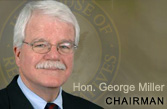






Press Releases
Reps. Miller, Woolsey Ask Labor Department to Take Steps to Prevent another Industrial Explosion |
||
|
Friday, February 8, 2008 |
||
|
WASHINGTON, DC -- U.S. Rep. George Miller (D-CA), chairman of the House Education and Labor Committee, and U.S. Rep. Lynn Woolsey (D-CA), chairwoman of the Workforce Protections Subcommittee, today asked Secretary of Labor Elaine Chao to take immediate steps to prevent hazards that likely led to yesterday’s deadly explosion at the Imperial Sugar refinery in Savannah, Georgia, and that continue to pose dangers at other industrial worksites in the U.S. The U.S. Chemical Safety Board recommended over a year ago that the U.S. Occupational Safety and Health Administration issue rules to prevent combustible dust explosions that have caused hundreds of deaths and injuries over the past two decades. “Our sympathies go out to the people of Miller and Woolsey made their request to Chao in a letter sent this afternoon. See below for the full text of the letter. To see a copy of the letter, click here. # # # February 8, 2008 Secretary of Labor The U.S. Department of Labor 200 Constitution Avenue, NW Washington, DC 20210 Dear Secretary Chao: Several employees of Imperial Sugar in As you are aware, the CSB conducted a major study of combustible dust hazards in 2006 and made a number of safety recommendations to the Occupational Safety and Health Administration (OSHA) and other parties. The CSB report identified 281 combustible dust incidents between 1980 and 2005 that killed 119 workers and injured 718. A quarter of the explosions occurred at food industry facilities, including sugar plants. The CSB concluded that “combustible dust explosions are a serious hazard in American industry, and that existing efforts inadequately address this hazard.” As the CSB report points out, methods used to control combustible dust hazards are well known. Detailed voluntary standards published by the National Fire Protection Association are effective in preventing combustible dust explosions. As we have tragically seen in Because no comprehensive federal OSHA standard exists to control the risk of dust explosions in general industry, the CSB recommended that OSHA issue a standard. To this date, more than a year after the CSB report was issued, there has been no indication that OSHA is considering a combustible dust standard. We are aware that OSHA issued a combustible dust Safety and Health Information Bulletin. We are also aware that OSHA launched a Combustible Dust National Emphasis Program, which the CSB recommended that OSHA conduct while developing a standard. We are interested in how this program and other related OSHA activities are being conducted. To that end, we would like to request that you provide us with the following information by February 25, 2008.
Even as the recovery effort continues in Sincerely, Chairman Lynn Woolsey Chair, Workforce Protections Subcommittee
FOR IMMEDIATE RELEASE |
2181 Rayburn House Office Building | Washington, DC 20515 | t: 202-225-3725
Site Map | Privacy Policy | Contact Us | Republican Views